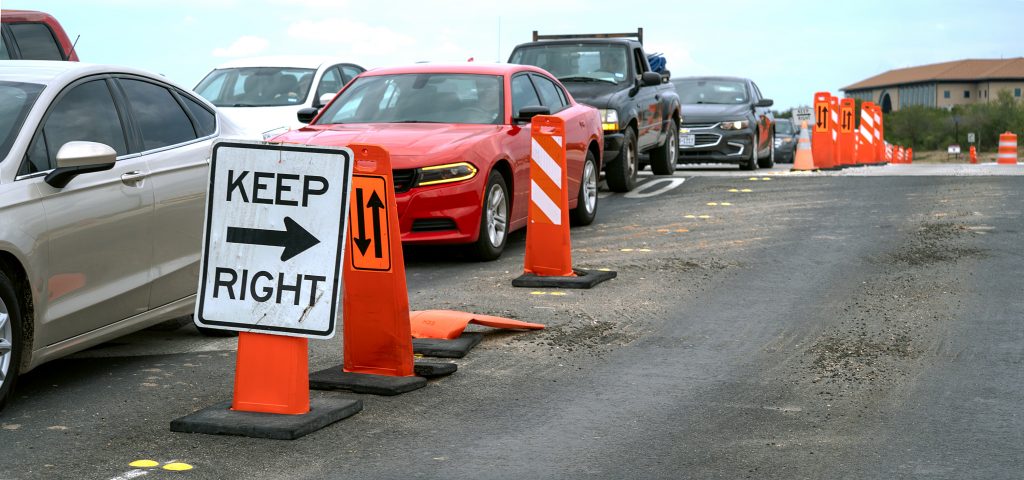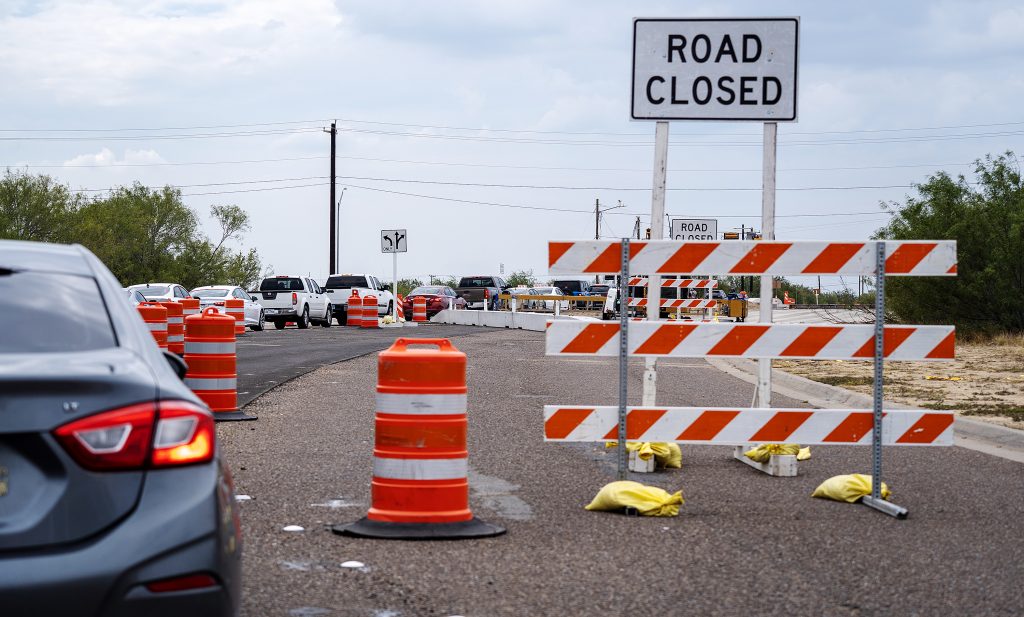CAMPUS: Construction results in traffic delays at University entrance
By Kaily Olivo
Editor-in-chief
Published Monday, Oct. 20, 2025
At the start of the Fall 2025 semester, construction at the main entrance created traffic for students. By October, those traffic complications have nearly returned to normal.
The construction began in early July and continued until late September. Associate Vice President of Finance and Administration Trevor Liddle said he sees this construction as an opportunity for Texas A&M International University.

Texas Department of Transportation construction slows down peak traffic hours on Sept. 7, 2025, near the main campus entrance.
“It’s an exciting time for TAMIU and for all of Laredo,” Liddle said. “And, for TAMIU to be able to play a role like we are in Laredo’s growth and success is really exciting, not only for us as an institution, but [for] our students and employees as well.”
In the interim, this construction created complications for those trying to exit TAMIU.
“I actually was stuck in traffic at the time … [and] it usually took like around, … an hour to get out of traffic,” sophomore Octavio Garcia said.
From a student’s perspective, Garcia had to figure out how to avoid the hour-long congested traffic times.
“Well, I think they could have avoided it by starting the construction of the entrance area of TAMIU a little earlier, like during the summer,” Garcia said. “So, that during the school year it wouldn’t have been such a big issue.”
But waiting in traffic wasn’t the only issue itself; this traffic affected his work life.
“Like, sometimes, it would take [a] long [time] to get out of school, and I would have to go to work,” he said. “So, I would show up a little late to work as well. So, it was just like a terrible experience overall.”
Despite this inconvenience, Liddle said the end results are a great thing for Laredo and TAMIU.

Texas Department of Transportation construction slows down peak traffic hours on Sept. 7, 2025, near the main campus entrance.
“They may say they are not enjoying it a whole lot right now,” Liddle said in September. “But when it is finished, the loop—as we call it today—will become Interstate Highway 69W and at University Boulevard it will be full interstate standards: six lanes wide, three each direction, north, south, unlimited access, all the turnarounds, the access roads, the right turn lanes, left turn lanes, all of those great things that go with a growing city and a growing campus.”
TAMIU was able to work with the Texas Department of Transportation to build this intersection for the future.
“So, you’ll see that the intersection is very different from the original one,” Liddle said. “And, part of that is to accommodate TAMIU’s growth in the next few years.”
Working with TxDOT on the project was important for TAMIU, especially considering the University’s growth with more than 9,000 current students. This project began when TAMIU’s enrollment was around 7,000 students.
TAMIU’s offices went into hyperplanning once the administration was notified of the intersection’s lane shift in mid-June.
“As with any construction project, it is a human process,” Liddle said. “We originally … looked at all of their plans, and they wanted to … build the road in the reverse fashion that it’s being built today.”
Originally, TxDOT wanted to work on the northbound lanes first and then the southbound ones, but TAMIU requested a change because they wanted to ensure it would be as easy as possible to enter the University. The goal was to make sure students could get onto campus without too much difficulty.
“The goal there was [that] it was more important for us to make sure … all students had the opportunity to get in as easily as possible,” Liddle said. “… So, we worked with TxDOT to reverse the order of the road construction.”
By doing the south first, the right turn lane into the entrance could be reopened.
“Inbound, we only have a very small section. It’s about 120 feet, where it’s just one lane in,” Liddle said. “Now, that’s still one lane in—I get it—but it opens up to the right turn lane and both eastbound lanes by the time you’re at the entrance … So, that allows traffic to flow better.”
Although existing traffic was taken into consideration, inbound traffic was prioritized more than outbound traffic.
“Existing traffic was taken into consideration,” Liddle began. “I will be completely transparent … inbound traffic was our first priority. Outbound traffic, well, not as much of a priority.”
Liddle focused on the situation’s small impact on TAMIU students.
“Unfortunately, they have the hyperaccurate plans and we work with TxDOT to try and minimize as much impact for our students as we can,” Liddle said.
His office also worked closely with TxDOT to rework the lights near the road. But after those adjustments, the camera sensors that control them were placed incorrectly. After they learned about the malfunction, there were many people working to fix it.
“Unfortunately, when they did the light move to get everything put in place, it looks like they didn’t line up all of the sensors correctly,” Liddle said. “… So, the sensors weren’t picking up vehicles in the way they should.”
Despite these issues, TxDOT arrived to fix them, but it did not go as planned.
“So, we had TxDOT out here several days, even before school started, and thought we had gotten the light fixed,” Liddle said. “Well, the first day of class proved to us that we perhaps didn’t have it as fixed as we had hoped.”
In regard to the first day of class, Liddle said there were additional factors in the traffic congestion.
“Well, not only was it our first day of school, but there was the additional traffic from UISD being in school, LISD being in school and they’re having school buses in our traffic pattern all of a sudden,” Liddle said. “And then, unfortunately, sometimes people don’t like to let other people in … So, that ultimately led to entrance three, having a huge traffic backlog.”
This traffic also formed due to the Lakeside subdivision light malfunctioning along with the University Boulevard light.
“That [Lakeside subdivision] light also wasn’t necessarily functioning as intended to be synced with the University Boulevard light,” Liddle said. “… There are gaps in traffic coming northbound [and] that’s because the lights are synced so that when they cycle, we can create that gap, which allows people to take the University entrance three.”
Liddle said the eagerness to respond and act on these issues, the process of choosing a route for students to go through, was also being considered, as well as testing a number of scenarios to see what could work.
This specific route, the entrance being cut down to one lane, turning left, was chosen based on a series of tests on flow patterns before students returned to campus for the Fall semester. Liddle said multiple people drove down University Boulevard to entrance two and U-turned to travel westbound, which slowed the traffic turning left and the entrance.
Closing the entire intersection and having everybody go around the campus loop to entrance two was also considered, but was quickly abandoned because it would be too disruptive to traffic.
“We did determine that there was a greater chance of an accident happening if we allowed people to turn right out of entrance one, which is why we said no …” Liddle recalled. “… We actually saw a couple of near misses; so, we were watching very, very closely.”
Because of the many considerations, Liddle said it was not a simple task.
“We took it extremely seriously,” he said. “We were very particular about the decisions that we made, once we had students back in the traffic pattern.”
Those traffic patterns were noticed as the school year began, he said, but his office also saw changes in traffic behaviors from prior years.
“We’ve noticed … that first day, there’s what we call the TAMIU hour, [which] is an empty class block between the end of the afternoon and the beginning of night classes,” Liddle said back in September. “Well, a number of students—more students than we [had] anticipated—decided to leave campus that Monday afternoon. We don’t see that happening, even now in week two.”
Those patterns changed, and the congestion went in spurts.
“Ten minutes, everything open and clear. Two minutes later, packed. Five minutes after that, empty again,” Liddle assessed. “That’s not a bad thing. That’s not a good thing. It’s just a thing. And so, we’re also responding to that while we’re directing traffic.”
As this traffic formed, Liddle directed cars alongside the TAMIU Police Department and other TAMIU directors while TxDOT worked to fix the issues.
“While I was out there directing traffic with our chief of police, our director of facilities and construction, our environmental health and safety director, TxDOT was across the street working on the light,” Liddle said. “So, we were all working in concert.”
Liddle recalls students and parents being kind to staff and administrators despite the possible annoyance from the traffic.
“Many of our students and their parents and our employees were kind and generous to the staff [who were] out there standing in the street,” Liddle said. “That was very heartwarming to see the work that our police officers did in trying to get as many people through the cycles as we possibly could.”
As the construction continued, Sept. 29 was the posted timeline from TxDOT to get the entrance returned to a somewhat normal state.
“We’re also closely watching the timeline with TxDOT and everything,” Liddle said. “… I won’t say it’s early on time or late because I don’t know all of their timing, but it’s exciting …”
Even with the roadblocks, Liddle said this has been a considerable learning experience.
“… all of the outbound and inbound lanes … return to what most people would say is normal,” Liddle said. “ It was a big learning experience for everybody, not a fun one.”
